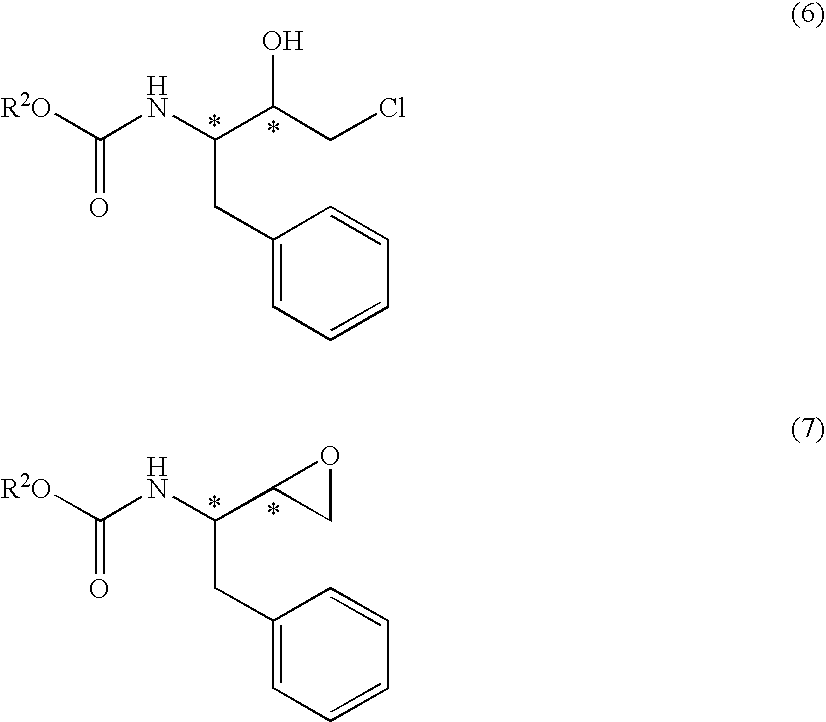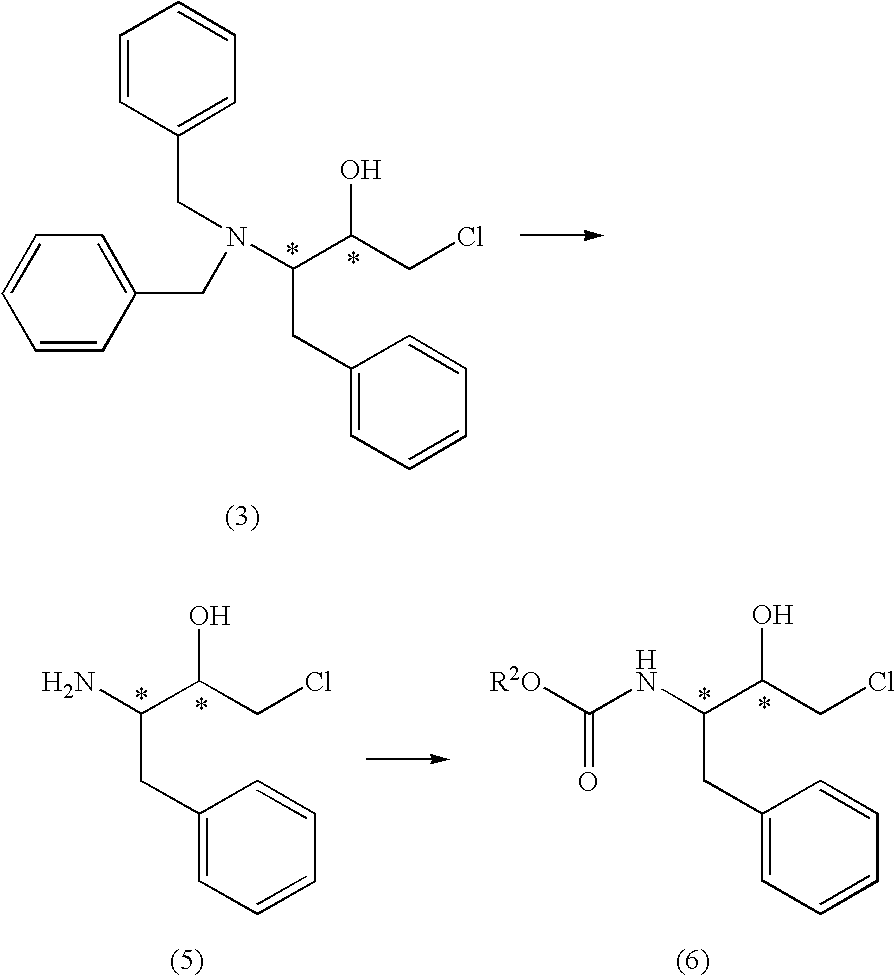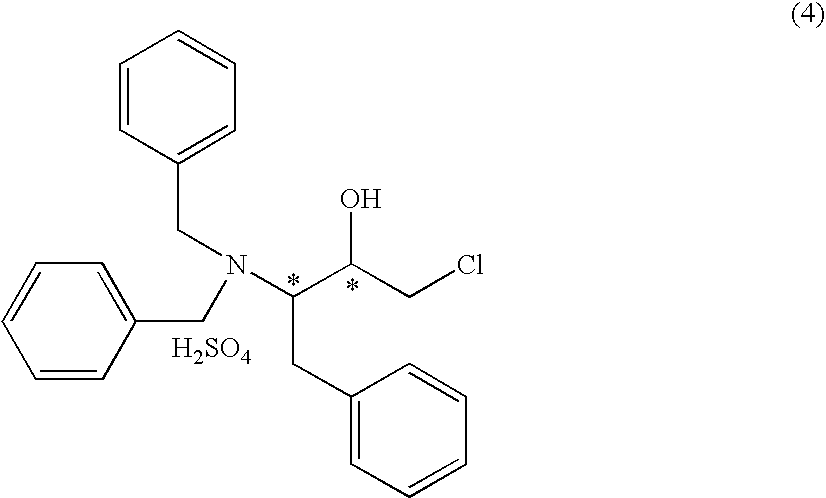Production method of aminochlorohydrin sulfate
a technology of aminochlorohydrin and sulfate, which is applied in the preparation of carbamic acid derivatives, organic chemistry, biocide, etc., can solve the problems of limiting the purification level, reducing the purification efficiency, and reducing the purity of compounds (5), (6) and (7), so as to achieve high purity, improve the purification efficiency, and facilitate the crystallization
- Summary
- Abstract
- Description
- Claims
- Application Information
AI Technical Summary
Benefits of technology
Problems solved by technology
Method used
Image
Examples
example 1
Production of crystal of (2R,3S)-3-dibenzylamino-1-chloro-2-hydroxy-4-phenylbutane sulfate
Step (1a): Production of (3S)-3-dibenzylamino-1-chloro-2-oxo-4-phenylbutane (containing byproduct)
[0165] To (2S)-N,N-dibenzyl-L-phenylalanine benzyl ester (3.4 g, net. 3.0 g, 6.89 mmol, 88.2 wt %) were added hexane (10.6 ml), tetrahydrofuran (11.3 ml), and bromochloromethane (1.23 ml), and the mixture was cooled to −70° C. under argon atmosphere with stirring. While stirring the solution, 2.64 M solution of n-butyllithium in hexane (5.35 ml) was added dropwise at the same temperature over 2 hours. After stirring the reaction mixture at the same temperature for 30 minutes, the reaction mixture was poured into 4 M aqueous hydrochloric acid solution (3.53 ml) at once to quench the reaction. The reaction mixture was allowed to stand still and the organic layer was separated. As a result of HPLC analysis, it was found that (3S)-3-dibenzylamino-1-chloro-2-oxo-4-phenylbutane (1.94 g, yield 74.5%) of...
example 2
Production of crystal of (2R,3S)-3-dibenzylamino-1-chloro-2-hydroxy-4-phenylbutane sulfate
Step (2c): (2R,3S)-3-dibenzylamino-1-chloro-2-hydroxy-4-phenylbutane (containing (2S,3S)-form thereof as diastereomer)
[0172] The crystal (5.0 g, 13.2 mmol, 100 wt %) of (3S)-3-dibenzylamino-1-chloro-2-oxo-4-phenylbutane obtained in the same manner as in Example 1, step (1b), was dissolved in a mixed solvent of methanol (40 ml) and dichloromethane (15 ml) under argon atmosphere, and the mixture was cooled to −10° C. To this solution was added, over 10 minutes, sodium borohydride (300 mg) divided into 10 portions, and the mixture was stirred for 1 hour. 36% Concentrated hydrochloric acid (0.682 ml) was added to the reaction solution to quench the reaction. Water (15 ml) was added at 20° C. to partition the solution, and the obtained organic layer was partitioned between water (15 ml) and dichloromethane (10 ml).
Step (2d): Production of (2R,3S)-3-dibenzylamino-1-chloro-2-hydroxy-4-phenylbutane ...
example 3
Production of (2R,3S)-3-tert-butoxycarbonylamino-1-chloro-2-hydroxy-4-phenylbutane
Step (3f): Production of (2R,3S)-3-amino-1-chloro-2-hydroxy-4-phenylbutane sulfate
[0176] The crystal (5.0 g) of (2R,3S)-3-dibenzylamino-1-chloro-2-hydroxy-4-phenylbutane sulfate obtained in Example 2 was dissolved in methanol (25 ml) and, after nitrogen substitution of the reaction atmosphere, 20% palladium carbon hydroxide (50 wt % wet, 150 mg) was added to the mixture. After hydrogen substitution of the reaction atmosphere, the mixture was stirred at 40° C., and debenzylation reaction completed in 3 hours. After nitrogen substitution of the reaction atmosphere, the catalyst was filtered off, and the filtrate was partitioned between dichloromethane (15 ml) and water (15 ml). The organic layer was extracted with water (10 ml), and mixed with the aqueous layer obtained earlier. The aqueous layer was analyzed by HPLC. As a result, (2R,3S)-3-amino-1-chloro-2-hydroxy-4-phenylbutane sulfate (3.1 g) (yield...
PUM
| Property | Measurement | Unit |
|---|---|---|
| Electrical conductance | aaaaa | aaaaa |
| Electrical conductance | aaaaa | aaaaa |
Abstract
Description
Claims
Application Information
 Login to View More
Login to View More - R&D
- Intellectual Property
- Life Sciences
- Materials
- Tech Scout
- Unparalleled Data Quality
- Higher Quality Content
- 60% Fewer Hallucinations
Browse by: Latest US Patents, China's latest patents, Technical Efficacy Thesaurus, Application Domain, Technology Topic, Popular Technical Reports.
© 2025 PatSnap. All rights reserved.Legal|Privacy policy|Modern Slavery Act Transparency Statement|Sitemap|About US| Contact US: help@patsnap.com



